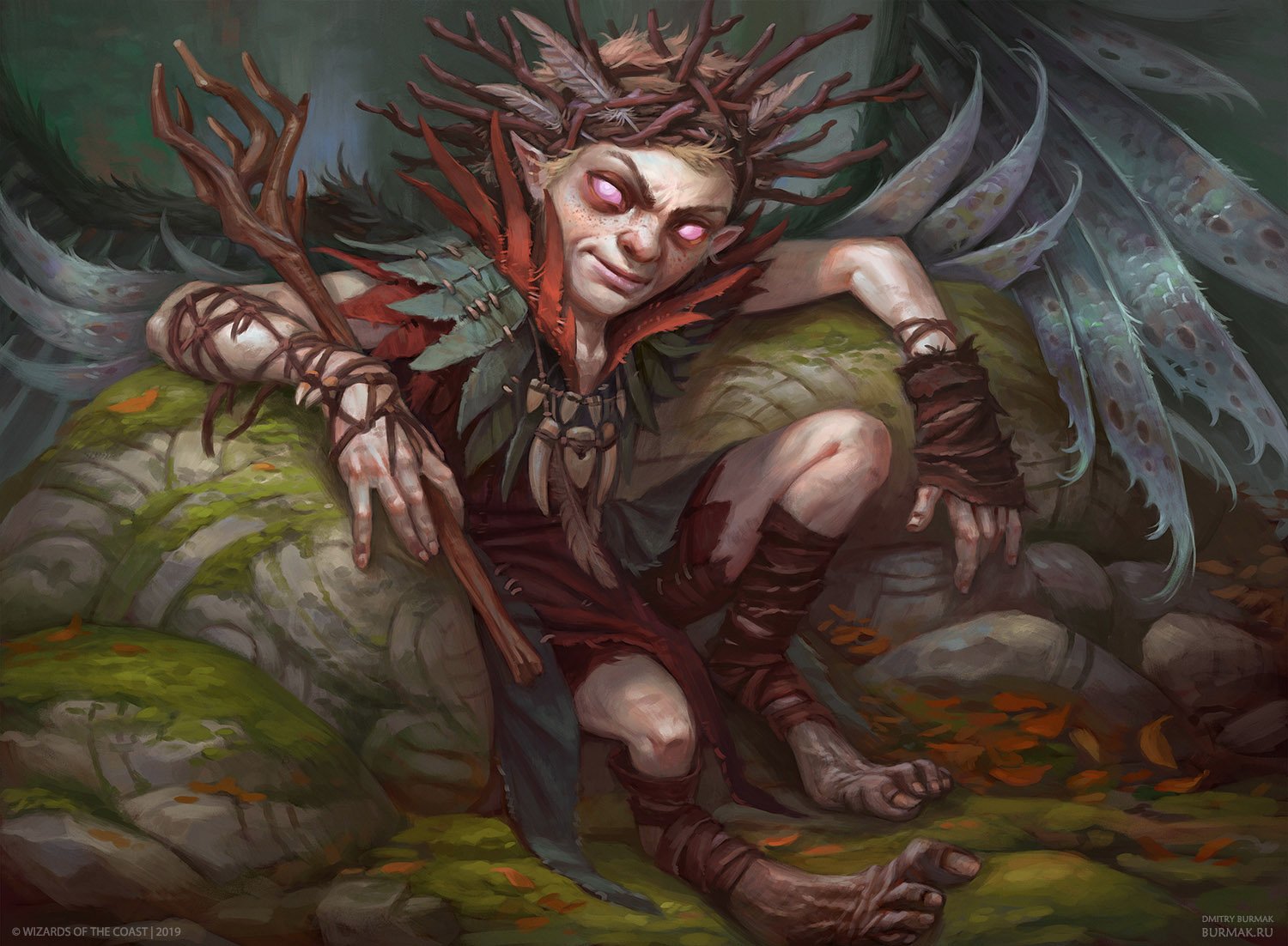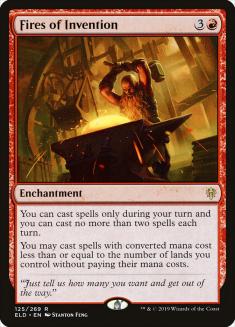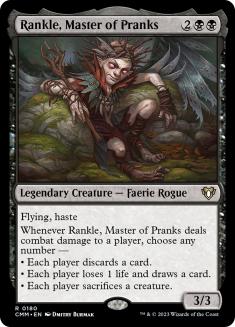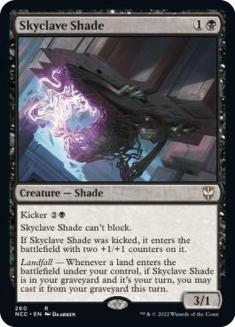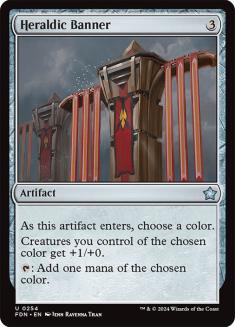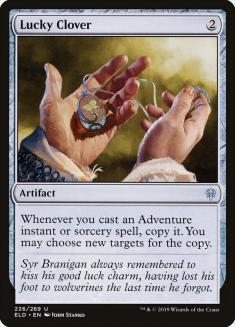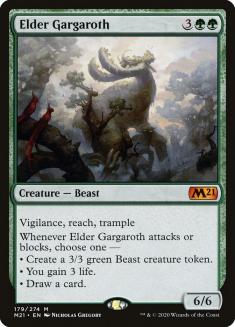Welp, here we go again. Battle lines for Zendikar Rising Standard have been drawn, and in a shocking turn of events, the ramp deck loaded with card advantage and incidental lifegain has cemented itself at the top of the format.
Creatures (17)
- 4 Lotus Cobra
- 2 Beanstalk Giant
- 1 Kenrith, the Returned King
- 4 Uro, Titan of Nature's Wrath
- 1 Terror of the Peaks
- 1 Radha, Heart of Keld
- 4 Omnath, Locus of Creation
Lands (28)
Spells (15)
Sideboard

In a vacuum, Four-Color Ramp’s ascendance wouldn’t really be cause for deep concern. Something must be the best deck, and it’s our job as Magic players to figure out how to dethrone it. However, the fact that the plan of this best deck looks similar to the plan of every other best deck we’ve seen over the past year is where things start to get troubling.
First, we’ve done this before. The first time a ramp/combo deck goes off and does explosive things, it’s exciting and kind of jaw-dropping. Fires of Invention using its mana explosion to steal two of my lands was wild when it came out of nowhere. Same goes for when Wilderness Reclamation opted to take all the turns. The tenth time these things happened, I was over it. Now, having heard the joke in multiple forms, I’m over all of them. Mana explosion, have an absurdly broken turn that invalidates every single turn that came before it… yawn.
The other part of the problem is that when competitive Magic is about this mode of gameplay once, you can easily attribute it to an accident. Card evaluation is challenging, especially when done in a limited timeframe. Mistakes happen, and it’s hard to begrudge anyone when the goals are in a good place. I’d even argue its good for every style of deck to get some brief time in the sun, and that includes strategies that people typically dislike playing against.
However, when competitive Magic routinely boils down to “How can I best generate and exploit mana advantages?” something is wrong. Either there is a conclusion that this is the optimal way to design Magic (perhaps for reasons that have absolutely nothing to do with Standard play), or there is a disconnect with how to properly balance the type of mana-ramping effects we are seeing. For purposes of this article, I’m going to assume it’s the latter, because thinking about that can yield some actionable items.
I would argue that the raw mana efficiency was the defining trait of Fires of Invention and Wilderness Reclamation. Not only did these cards ostensibly double your mana, but they were often “free” on the turn you cast them. In the context of a lower-powered format like Standard, that type of efficiency will always prove to be exploitable.
Things are a little different when it comes to Uro, Titan of Nature’s Wrath. Uro lacks the raw explosiveness of the previously banned options, but it makes up for it by invalidating some of the traditional weaknesses of ramp. If you spend the early turns of a game developing mana, you should have vulnerability to aggression and disruption. Uro skips both those weaknesses with its lifegain and its ability to function as a recursive threat.
If a control deck wants to trade a disruptive piece for Uro’s ramp, you can just punish them later when Uro escapes. If they let it resolve, you’ve gained a mana advantage at zero card cost, and this deficit will also manifest as the game goes long. Against the aggressive decks, the three life gained often negates the first two turns of their work, and now you’re casting spells that just dwarf theirs on quality for the rest of the game.
Omnath, Locus of Creation is somehow Uro and Fires of Invention combined. It can pay you back on your mana investment the turn it’s cast. It leads to turns with absurd amounts of mana. It will often gain dozens of life over the course of a game that somehow lasts a few more turns. And sure, it draws a card when it enters the battlefield as well. The theoretical limitation is its mana cost, but I saw someone remark that the Omnath decks have better mana than the Gruul decks and I can’t really argue that point. It’s not difficult to cast Omnath.
What this means is that typical modes of fair Magic are invalidated. Not only will lifegain from Uro and Omnath erase any chip damage, but those creatures will eventually do a fantastic job of bricking aggression on the ground, especially in combination with the now widely played Felidar Retreat. Going super-long, Uro’s recursion still overwhelms decks trying to deny resources.
We’ve got to look for significant bursts of damage, ways to get into the air, and disruption tied to our aggression — all while making sure the game doesn’t stretch into infinity. Thankfully, I know just the Faerie for the job.
The only (admittedly limited) success I’ve had playing fair has been on the back of Rankle, Master of Pranks. While it’s pretty easy to paint scenarios where any one of Rankle’s abilities is made to look silly by the potential output of Four-Color Ramp, if backed up by the right cohorts it can keep an Omnath player off-balance just long enough to squeeze out a victory. Whether it’s taking out Lotus Cobras to prevent the large combo turn, serving as the KO punch in a resource denial plan, or just being an unblockable clock, Rankle has shined, and I think it’s one of the two cards that benefited most from rotation, the other being Escape to the Wilds.
A rundown of Rankle’s modes seems a bit forced. Part of Rankle’s greatness is its versatility. Trying to suggest that a certain mode should be used in a prescribed way isn’t going to get us far. Broadly speaking, I suspect people don’t discard often enough, and draw far too often.
Against Omnath, I will almost never take a card and will almost always force a discard. They need some amount of resources to get an engine going, and if you’ve kept them off their plan, they’re likely trying to combine land drops plus a creature to fire off their big turn. Every resource denied matters, even if they have eventual capability to rebuild with Uro and Escape to the Wilds. Those rebuilds take time. These decks are all built with either ample card advantage or recursive threats to facilitate your own discards. Don’t be afraid to give up a good card if it means you’re denying a great one on your opponent’s side.
On to the decks.
Creatures (26)
- 3 Kitesail Freebooter
- 4 Rankle, Master of Pranks
- 3 Murderous Rider
- 1 Tymaret, Chosen from Death
- 3 Serrated Scorpion
- 4 Whisper Squad
- 4 Skyclave Shade
- 4 Nullpriest of Oblivion
Lands (19)
Spells (15)

This deck looks a lot like a list I proposed during preview season after the reveal of Skyclave Shade, and it’s almost surprising how well our plan has held up in the face of Omnath. This update is inspired by the work of Mason Clark and Telemokos, who brought some Heraldic Banners into the mix. I’m not over the moon about the card, but our three-mana slot has gotten much worse, and this is a way to guarantee we are getting to the vital fourth mana to cast Rankle.
The simple setup here is that if an opponent can’t keep an Omnath or Lotus Cobra on the battlefield, then your clock gets a chance to matter, so long as you can fly over Felidar Retreat tokens. This becomes even more true as Omnath decks begin to drift away from Genesis Ultimatum. Skyclave Shade plus Demonic Embrace generates that Embercleave-like burst damage starting on Turn 3, and once that type of explosiveness is easily achievable, the idea of managing Lotus Cobra and Omnath for just a couple of turns becomes more palatable.
Rankle plus Skyclave Shade is the hottest couple of 2020. Shankle (sorry) is an engine in a deck that really has no business having one. It can keep pushing on whatever axis your opponent is being pressured on. If you’ve kept Lotus Cobra and Omnath off the table, Rankle can continue to do so. If they’ve had to rely on cards like Felidar Retreat that don’t generate resources, maybe Rankle can squeeze them on that axis.
I’m going to keep building decks and thinking of ways to force Omnath and Uro out of the metagame. But I expect any success I find to be short-lived. Some cards are just too powerful to shut down.
I still like Bloodchief’s Thirst in smaller numbers to kill Lotus Cobra and deploy a threat, but our one-drops to cast alongside Bloodchief’s Thirst on Turn 2 are pretty awful, we don’t have that many of them, and the reality of Omnath is starting to make itself felt. Heartless Act in response to a Fabled Passage activation can truly change the entire course of the game, not to mention the fact that Winota, Joiner of Forces still deserves our respect.
This is my favorite way to get aggressive if my sole target is Omnath decks, but what if this isn’t a one-deck metagame and control finds a way to insert itself into the mix?
Creatures (25)
- 4 Rankle, Master of Pranks
- 4 Foulmire Knight
- 3 Order of Midnight
- 4 Lovestruck Beast
- 2 Beanstalk Giant
- 4 Murderous Rider
- 4 Edgewall Innkeeper
Lands (18)
Spells (17)

We’re giving up clock for staying power with this setup, and if the goal were simply to beat Omnath, I wouldn’t recommend the change. However, if we’re trying to next-level some folks and target the next big thing, there’s plenty to love here. The aerial clock isn’t totally absent with Rankle and Order of Midnight stepping in admirably. Again, it can only matter if your deck is fantastic at keeping the key creatures off the battlefield, and this deck has removal in spades. It also has plenty of card advantage and small creatures that you’re willing to burn to Rankle’s abilities.
The manabase is an obvious Achilles’ heel with only Temple of Malady capable of producing green and black mana. However, there’s some beneficial stuff going on here as well, as we get to cheat 26 lands into our aggressive deck’s manabase while picking up eight spells that play very well in our creature-centric deck. I would be more concerned about playing eight of the mythic double-faced cards (DFCs) if decks like Mono-Red were realistic, but our friends Uro and Omnath are doing their part to keep them out of the metagame for us. Against bigger burst damage decks, our copious removal should do the job for us.
If those decks do happen to rise up, I like our setup in sideboard games. We can give up on the Lucky Clover stuff and just become a midrange Golgari deck, fully banking on our full four(!) copies of Elder Gargaroth. I’m done messing around with a couple cheeky copies of this card. It’s almost impossible for some decks to beat while it remains on the battlefield, so I’m going to make sure that’s the case as often as possible.
Meanwhile, against the Omnath decks we shift our resource denial plan into full gear with three copies of Reaper of Night. Harvest Fear doubled up by Lucky Clover strikes me as a real plan and Rankle will be able to put the finishing touches on their destroyed hand.
Creatures (30)
- 3 Rankle, Master of Pranks
- 3 Vito, Thorn of the Dusk Rose
- 4 Archfiend's Vessel
- 4 Speaker of the Heavens
- 2 Orah, Skyclave Hierophant
- 4 Cleric of Life's Bond
- 2 Taborax, Hope's Demise
- 4 Luminarch Aspirant
- 4 Nullpriest of Oblivion
Lands (22)
Spells (8)

Clerics decks I’ve seen have mostly focused on the inevitability side of things, looking to maximize Orah, Skyclave Hierophant. I don’t think you can do that against Four-Color Ramp. I’m taking things in a different direction and looking at Clerics as a way to push through evasive damage, and force lethal even on battlefields that Omnath has taken over. The key piece of that plan is Vito, Thorn of the Dusk Rose. In combination with all of our lifelinkers, it will make the early-game damage from cards like Luminarch Aspirant actually matter.
Evasion also comes from a strong commitment to the skies. Taborax is another card I haven’t seen much of in the Clerics lists floating around, but once Rankle is providing a sacrifice outlet, it gets much better and should grow large quickly. I’ve also made a commitment to making Speaker of the Heavens a real card. It should either power up reliably or force a removal spell that paves the way for one of our powerful legends to eventually take over the game.
Rankle’s role here is muted, as it only really finds strong synergies in combination with cards like Taborax or Orah. That’s fine. It speaks to just how powerful Rankle is facially right now. Even lacking synergies, it will still be an important evasive threat that can occasionally kill one of the problematic creatures capable of snowballing games in Four-Color Ramp.
Creatures (18)
- 2 Rankle, Master of Pranks
- 1 Brazen Borrower
- 2 Lurrus of the Dream-Den
- 4 Archfiend's Vessel
- 4 Acquisitions Expert
- 4 Sea Gate Stormcaller
- 1 Nullpriest of Oblivion
Lands (16)
Spells (26)

This is probably the deck I’m most excited about, if only because it feels like playing a style of Magic that hasn’t been viable for a very long time. We’re a disruptive deck built to leverage the power of Sea Gate Stormcaller. While it’s clear we don’t have the next Snapcaster Mage on our hands, that doesn’t mean the card can’t shine when given the appropriate focus. The two huge payoffs here are Village Rites to draw four and Agonizing Remorse to take your opponent’s best two cards. Either line sets up Rankle for success as the game goes long. Of course, just killing two of your opponent’s creatures feels pretty good.
You do some really absurd things with looping Acquisitions Experts that can prevent even the most card-advantage-focused ramp deck from getting to a point where they can play the game. Sometimes though, Escape to the Wilds will come along and ruin your day. There’s a reason people want to play the best deck, and the fact that Four-Color Ramp is always drawing live is a huge selling point. It won’t always feel great to fight the good fight.
This deck puts a lot of eggs into the Mystical Dispute basket. Considering the spectrum once more, I’d put this as more of a deck for a single-deck metagame. Beating other things, or even diversified plans from the Four-Color Ramp decks, will require a lot of sideboard tuning, and maybe some clearer targets.
Creatures (28)
- 4 Rankle, Master of Pranks
- 4 Brazen Borrower
- 4 Thieves' Guild Enforcer
- 4 Merfolk Windrobber
- 4 Zareth San, the Trickster
- 4 Nighthawk Scavenger
- 4 Soaring Thought-Thief
Lands (21)
Spells (11)
Sideboard

I’ll close out this round of decklists with Sam Black’s submission for this week’s Zendikar Rising Standard What We’d Play. While Sam and I often disagree on the execution, I think we see big-picture trends similarly. His hard focus on Rankle in his Rogues list looks great to me, and this is a perfect example of the disruption plus clock setup. I’ve mostly left this archetype to others since I know it’s gotten plenty of focus, and I’m excited to get some games in with Sam’s list.
I’m going to be real with you. This won’t be an easy battle. There is a reason these Four-Color Ramp decks have gotten so much attention so quickly. They are problematically explosive. They are malleable in both maindeck and sideboard. And they do absolutely everything well. Be wary of all of the people coming out of the woodwork to tell you how they are crushing the deck on ladder. Everyone said similar things about Fires of Invention, and Wilderness Reclamation, and Field of the Dead, and… well, you get the picture.
Something is wrong here, and it’s not just doom-saying or clout-chasing. I’ll keep building decks and thinking of ways to force Omnath and Uro out of the metagame. But I expect any success I find to be short-lived. Some cards are just too powerful to shut down.

